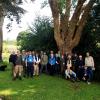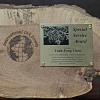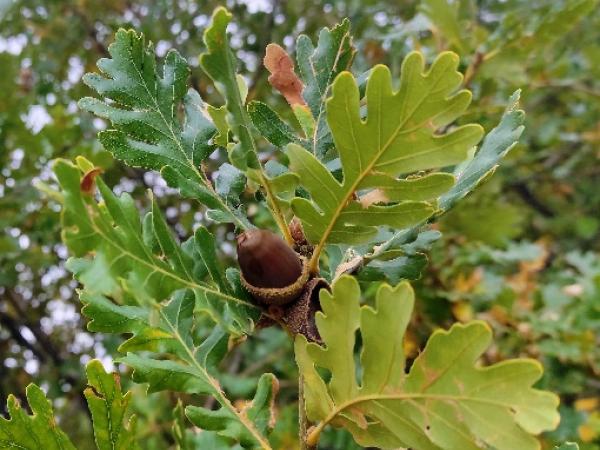Editor's Picks
Plant Focus
Eric Boa 1and Liliana Franco-Lara 2
1 Independent consultant and Senior Research Fellow, University of Aberdeen, King's College, Aberdeen, AB24 3FX, United Kingdom.
2 Universidad Militar Nueva Granada, Facultad de Ciencias (Biología), Carrera 11 n.° 101-80, Bogotá, Colombia.
This article is based on an original version published under the title Is Planting Native Trees Preferable? in the newsletter Only Connect.
I (Eric Boa) have been studying tree health problems for many years and keep a roving eye for new pathogens and pests, as well as ones already known. My interest in tree diseases in Colombia began over 20 years ago, and since then I’ve been back regularly to work with my co-author. In this short article we’ll describe a recently reported disease of Quercus humboldtii, an oak species native to Colombia, where it is known as roble. A “new” disease doesn’t mean that a tree is about to be wiped out or that risks are posed to oaks beyond Colombia. Many, though, will be worried by destruction already caused by sudden oak death, oak processionary moth, and oak wilt. We’ll provide a short summary of what is already known about the new oak disease and its possible implications.
The disease on Q. humboldtii was discovered by accident during investigations into a related disease which seriously affects urapán, the major street tree in Bogotá. Urapán is Fraxinus uhdei, a species of ash native to Mexico and Central America and found in Andean cities in Colombia as well as Ecuador (or at least in Quito). The common thread is that the oak and ash diseases are both caused by phytoplasmas, specialized bacteria that are spread by insects and in planting material (but not seeds). Phytoplasmas disrupt growth and can seriously weaken the health of trees. Liliana Franco-Lara and her colleagues saw similar symptoms on oak to those they knew were associated with phytoplasmas on urapán. When they investigated further they found a similar association on roble (Q. humboldtii) in Bogotá. More about this later; first, some background on urapán.

The Bogotá city authorities have planted vast numbers of urapanes over the last 50 years or so. At first all seemed fine. The trees grew well and provided an elegant and soothing buffer to the hustle and bustle of a frenetic city, one with around 8 million people. Urapanes line major roads and residential areas and are in parks and other green spaces, particularly in the north of the city. Mature trees are up to 15–20 m tall. They and other urban trees are a vital part of everyday life.
Sometime in the 1990s, possibly earlier, the urapanes started to look a little ragged; loss of leaves, thin crowns, and unusual shoot development, particularly sprouting from main trunks and branches. Symptoms occurred throughout the city but were particularly noted in the north, richer districts where more trees have been planted. In its most damaging form, the disease, known as ash or urapán yellows, would result in a tree that looked like the erect Lombardy poplars (Populus nigra) associated with Tuscany, albeit lacking leaves and with dead branches, rather than the full, rounded crown seen in healthy urapanes.

First reactions to the decline of trees were muted. An early theory was that the ragged appearance was due to an insect, yet the evidence didn’t stack up. The delay in doing detailed research into the cause of the decline delayed responses, such as stopping the planting of urapán. One thing is certain today: urapán is no longer a preferred street tree. Other explanations focused on the often adverse growing conditions faced by urban trees: regular root disturbances as roads are dug up and repaired, regular lopping of branches to allow free passage of buses and trucks, or reducing interference with overhead power cables. The vague notion that “increased air pollution” was responsible also got a mention too. True, airborne particles from car exhausts and general dust and dirt can clog up the ability of leaves to transpire. It’s a tough life for street trees.
None of these suggested causes fully explained the distinct symptoms seen. Moreover, research reports from the US suggested another alternative. Ash yellows was first described from the US in the 1920s and is now widespread, mainly on Fraxinus americana. The association with phytoplasmas was not confirmed until the 1980s, when new diagnostic methods became available. Scientists at the Universidad Militar Nueva Grenada (where Liliana Franco-Lara works) then began to explore the possibility of phytoplasma involvement in urapán in the late 1990s. Over the last twenty plus years Liliana and colleagues have investigated not only the urapán disease but a series of related diseases on other street trees in Bogotá. Once local scientists became familiar with phytoplasma symptoms on urapán, they started to see similar features on other trees. This is where Q. humboldtii enters the scene.

Around 30,000 Q. humboldtii have been planted in Bogotá, a scheme started around 20 years ago. A significant number of trees show symptoms that are known to be associated with phytoplasmas. The degree of damage varies and can be serious. We would hesitate to call this a calamity, yet we are concerned that there are still major gaps in our knowledge of the disease.
We believe that the urapán yellows phytoplasma came originally from the US on imported seedlings of F. uhdei. Similar symptoms have been seen on ash in Quito (almost certainly urapán) and in Cochabamba on ash species (possibly F. americana). A field trip in June 2023 revealed urapán yellows hundreds of kilometers north of Bogotá in remote rural areas of Santander. The phytoplasma is on the move, though exactly how is unclear. More worryingly, we found phytoplasma symptoms in natural populations of Q. humboldtii in the same areas. Salix humboldtiana, a native willow planted throughout the Sabana de Bogotá and beyond, is being hammered by a related phytoplasma disease. Samples from natural populations of roble have still to be tested for phytoplasmas, though there is little doubt that this is the same disease confirmed in Bogotá.
We’ve prepared a basic guide to symptoms of the roble disease which you can view below. Note the elongated shoots that stick above the canopy, or spikey growth, and yellowish leaves when just emerging. Such shoots may also occur lower down in the crown. We know that these unusual shoots are associated with phytoplasmas in Bogotá. Get in touch (email addresses embedded in author names above) if you see something similar—whatever the oak species.
There has been one report of phytoplasmas on oak in Lithuania. This is the only other example we're aware of. We suspect that phytoplasmas are more widespread on oak, if only because of the many insects that feed on it, including those types that are known vectors of phytoplasmas. Colombia is truly a megadiverse country, a paradise for plants and insects. It is likely to be rich in phytoplasmas too, though it is difficult to confirm because of limited laboratory testing. The starting point for mapping phytoplasmas is to report suspicious symptoms on any oak and from any country. Contact us and help us learn more about an intriguing type of disease that demands more attention.
















